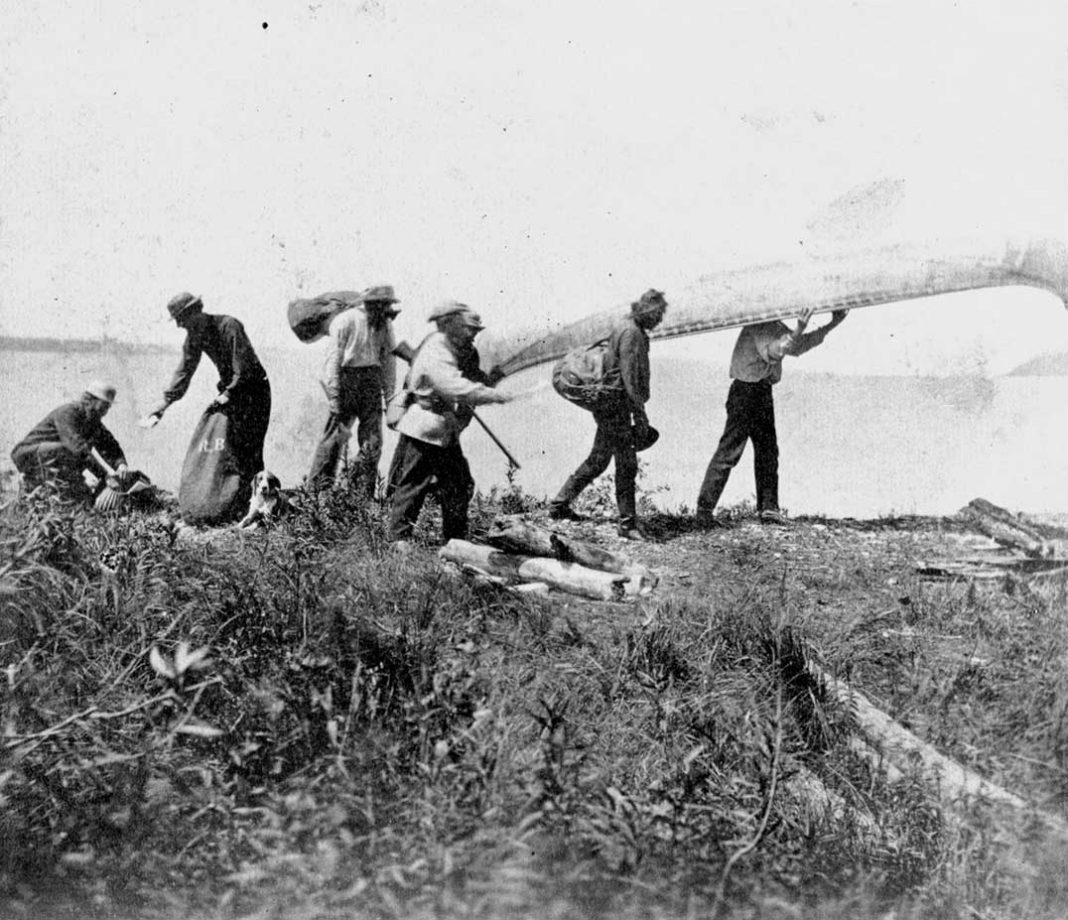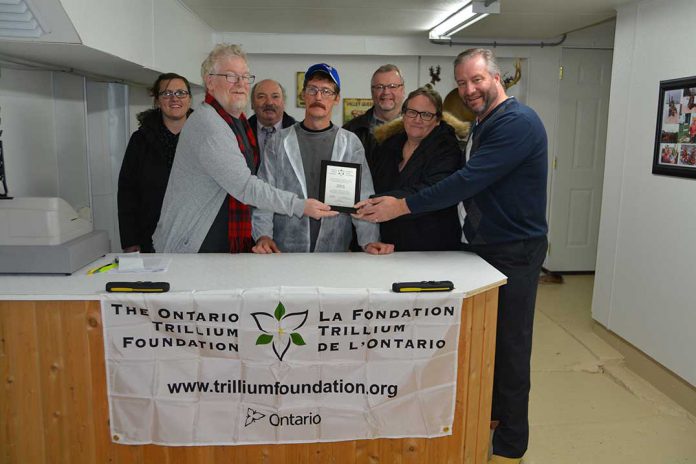As Canada turns 150, a look back at the Island in the year of Confederation
by Shelley J. Pearen
Manitoulin Island was in transition in 1867. Journalists writing in the mid-1860s described it as being forcibly transformed from an isolated island reserved exclusively for its Indian residents, into a reputedly vast resource for farmers, lumbermen, fishermen and speculators.
Manitoulin Island (Mnidoo Minising or Odawa Minising, the “Island of Manitou” or the “Island of the Odawa”) has been the home of Anishinaabeg, the First or Original People for thousands of years.
In 1836, the Anishinaabe proprietors of Manitoulin signed an agreement with the government in which both parties agreed to withdraw their claims to the islands, making “them the Property (under your Great Father’s Control) of all Indians who he shall allow to reside on them.” The ogimaag (chiefs) who signed the agreement in 1836 believed the government was acknowledging and affirming their title to Manitoulin and the adjacent islands; they were agreeing to share it, forever.
Twenty-five years later, in 1861, Manitoulin Island’s Anishinaabeg met new government representatives who claimed that the Anishinaabeg had not populated Manitoulin sufficiently, so a new agreement should take place. An offer to allow 25 acres for each Anishinaabe family, plus non-Native settlement on the balance of Manitoulin, was flatly rejected.
The following year, in October 1862, senior government officials brought a revised offer to Manitoulin. Some of the Anishinaabeg succumbed to persuasion and signed a new agreement or treaty in which most of the island was surrendered. They subsequently claimed that they had been threatened and frightened into surrendering the land, and requested cancellation of the treaty.
The people of Wikwemikong refused to sign the government’s offer and their peninsula remains unceded or unsurrendered to this day.
Surveyors started exploring the Island within weeks of the signing of the treaty. As the surveyors worked Manitoulin’s Anishinaabe residents carried out a campaign to have the treaty annulled. They petitioned the governor repeatedly, and successfully attracted the attention of journalists and members of Parliament.
Concurrently, the local superintendent of Indian Affairs attempted to resettle Manitoulin’s Anishinaabe residents according to the terms of the treaty. The treaty reserved potential harbours, mill sites and town plots for non-Native settlement, coincidentally the current locations of most Anishinaabeg.
The people of Wikwemikong refused to sign the government’s offer and their peninsula remains unceded or unsurrendered to this day.
In June 1866, land was released for sale in the newly created Howland, Sheguiandah, Bidwell, and Billings Townships, although many Anishinaabeg were still residing on these lots. They were persuaded or coerced over the following four years to relocate to Sheguiandah, Sucker Creek, or Sucker Lake.
Settlement lands were sold at 50 cents an acre with a requirement for immediate and 3-year continuous residency. Except for a brief initial rush, sales were slow and the price was reduced to 20 cents an acre in 1867. The price reduction created a few bargains, but also meant there would be no financial benefit for the treaty Anishinaabeg who were also forbidden to purchase lots.
Clearly the descriptions of Manitoulin as being in transition in 1867 were accurate.

photo by Robert Bell
Library and Archives Canada
New Year’s Traditions
The New Year has been documented on Manitoulin since December 31 1844 when Jesuit priest Father J.P. Choné described his first New Year’s Eve at Wikwemikong. Choné recorded:
“First, the chiefs come in a body towards evening. At nightfall the principal people below the chiefs conducted by two miccinawe, gather together in front of the house of their Father the Black Robe. They start with a serenade of horns and a type of drum, thus forming an orchestra. After the serenade the 1st miccinawe starts a chant of “Hurrah,” and all the company repeat the “Hurrah” with the same intonation, then the miccinawe: “Hurrah”, the company: “Hurrah,” the micc.: “Hurrah,” then the company “Hurrah” and then guns are discharged. The ceremony is repeated three times for a Black Robe and once for a chief. As we were two priests there were six serenades, six “Hurrahs,” and six gun shots. Then the leaders of the company came and greeted the Black Robes, offering their hands. The Black Robe gives something, some cake or some sugar or tobacco and pipes and makes little cakes for all the visitors.”
The following morning, January 1 1845: “All the natives, grands et petits, came to greet us. Some knelt, others genuflected, others only offered their hand. This seems to be a custom degenerated from coming to ask their Father’s blessing.”
The New Year’s gatherings continued and soon evolved into competitions between Manitowaning and Wikwemikong. In 1848-49 the Jesuits recorded that Manitowaning officials had provided their Indian visitors with larger and fatter bread rolls, well-sugared cups of tea, and greetings from not only the superintendent, but the doctor, school master and Anglican minister, while the volume and quality of the Wikwemikong bread rolls had diminished since the previous year.
Rev. Peter Jacobs, the Anishinaabe minister, described New Years at Manitowaning in January 1863-64.
“On New Year’s Eve about 20 Indians paid a visit to the superintendent, to myself, and to Dr. Layton. They also visited some of the other people in the village. The evening was very stormy but this did not prevent them from making their accustomed New Year’s Eve visit. They were dressed up in true Indian style. Their faces were painted with vermillion and black paint, Eagle, hawke, owl and turkey smitts were fastened on their heads and a string of quills hanging from one shoulder like a belt. One had a beautiful headdress of feathers which hung halfway down his back. One had a drum and another a rattle. While they were at the superintendent’s they were asked to sing and dance as the Indians in former days used to do. Presently the head man of the party, who was neatly dressed, took the drum and sang a war song, and about six of the Indians danced round and round, one of them shaking the rattle. While dancing they occasionally gave the war whoop. The dancing and singing were very exciting. The Indians went through the same performance at the other houses. They received something at each house. It is only once or twice a year that they dress themselves in the way I have described. New Years Day was a very stormy day. Comparatively few in consequence attended church. Nearly all who went to church wore snow shoes, women as well as men. After the service all the Indians called at all the houses, where they received cakes.”
In addition to greetings and gifts among the community, chiefs and warriors from as far away as Shishigwaning and Mitchegewedenong (M’Chigeeng) visited, and social calls were exchanged between priests and officials at Wikwemikong and Manitowaning.
At Manitowaning New Year’s 1866-67 would have included the usual visits, greetings and gifts, however several medical emergencies meant the festivities were not recorded. Dr. Thomas Simpson, the newly appointed medical doctor, responded to two urgent requests from Little Current while Rev. Jabez Sims, walked to South Bay to offer spiritual and medical help for Chief Wabenasemin. By the end of the first week of 1867, Mr. Abrey’s child and an un-named Anishinaabe woman had recovered, but the chief had succumbed to his injuries and been buried.
At Wikwemikong, on December 31 1866: “The Warriors and Natives came as ordinarily wishing Happy New Year about 6 o’clock in the evening. We gave them the customary presents. The Daughters of Mary visited.” On January 1: “Everything as usual. Fine weather, quite mild. The ice in the bay is very weak. The Congregations came, one by one, wishing Happy New Year. The Fathers visited the Daughters of Mary.” The following day however another medical emergency arose and the Father Superior travelled to Jiboananing (Killarney) to attend to the elder Salomon.
Nearly all who went to church wore snow shoes, women as well as men.
On Manitoulin in 2017, 150 years later, residents still exchange greetings and step up to assist in emergencies. The only marked difference is that they are no longer obliged to walk between Manitowaning and Little Current, or South Bay to do so.
EDITOR’S NOTE: Shelley Pearen has been researching Manitoulin history for 40 years. Her ancestors settled on Manitoulin prior to 1867 and witnessed this period of transition. She is the author of the popular books ‘Four Voices: The Great Manitoulin Island Treaty of 1862’ and ‘Exploring Manitoulin.’ Shelley is currently transcribing and translating the Jesuit’s Wikwemikong Diarium 1844-1873.





